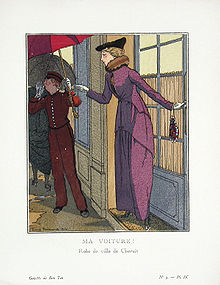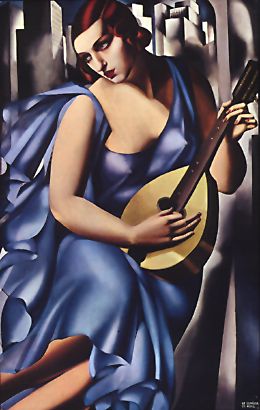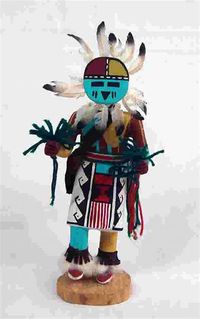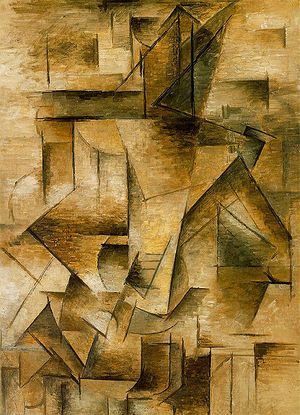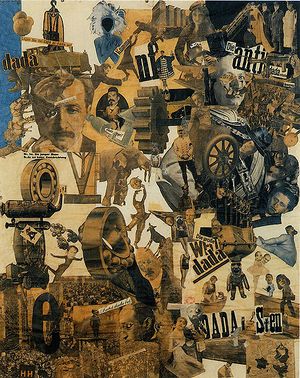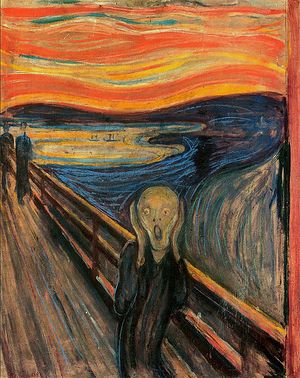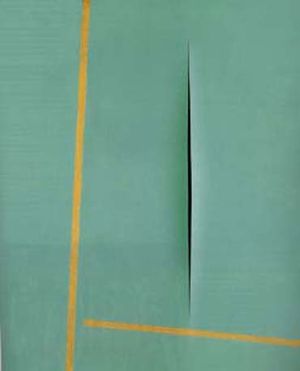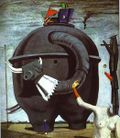Art Deco
Art Deco
Art Deco is an eclectic artistic and design style which had its origins in Paris in the first decades of the 20th century. The style originated in the 1920s and continued to be employed until after World War II. The term "art deco" first saw wide use after an exhibition in 1966, referring to the 1925 Exposition Internationale des Arts Décoratifs et Industriels Modernes that was the culmination of high-end style moderne in Paris. Led by the best designers in the decorative arts such as fashion, and interior design, Art Deco affected all areas of design throughout the 1920s and 1930s, including architecture and industrial design, as well as the visual arts such as painting, the graphic arts and film. At the time, this style was seen as elegant, glamorous, functional and modern.
Art Deco moved away from the soft pastels and organic forms of Art Nouveau and embraced influences from many different styles and movements of the early 20th century, including Neoclassical, Constructivism, Cubism, Modernism, and Futurism.[ Its popularity peaked in Europe during the Roaring Twenties and continued strongly in the US through the 1930s. Although many design movements have political or philosophical roots or intentions, Art Deco was purely decorative.
Art Deco experienced a decline in popularity during the late 1930s and early 1940s, but experienced a resurgence in the 1960s with the first book on the subject by Bevis Hillier in 1968 to coincide with the Minneapolis exhibition and continued with the popularization of graphic design in the 1980s. Art Deco had a profound influence on many later artistic movements, such as Memphis and Pop art.
Surviving examples may still be seen in many different locations worldwide, in countries as diverse as China (Shanghai), UK, Spain, Cuba, Indonesia, the Philippines, Argentina, Romania, Australia, Canada, New Zealand, India, Brazil, Colombia, and the United States (primarily in Miami Beach, Los Angeles, and New York City). Many classic examples still exist in the form of architecture in many major cities. The Empire State Building and Chrysler Building, both in New York City, are two of the largest and best-known examples of the style.
- More information is available at [ Wikipedia:Art Deco ]
Art Nouveau
Art Nouveau is an international movement and style of art, architecture, and applied art - especially the decorative arts-that peaked in popularity at the turn of the 20th century (1890–1905). The name "Art Nouveau" is French for "new art". It is also known as Jugendstil, German for "youth style", named after the magazine Jugend, which promoted it, and in Italy, Stile Liberty from the department store in London, Liberty & Co., which popularized the style. A reaction to academic art of the 19th century, it is characterized by organic, especially floral and other plant-inspired motifs, as well as highly stylized, flowing curvilinear forms. Art Nouveau is an approach to design according to which artists should work on everything from architecture to furniture, making art part of everyday life.
The movement was strongly influenced by Czech artist Alphonse Mucha, when Mucha produced a lithographed poster, which appeared on 1 January 1895 in the streets of Paris as an advertisement for the play Gismonda by Victorien Sardou, starring Sarah Bernhardt. It was an overnight sensation, and announced the new artistic style and its creator to the citizens of Paris. Initially called the Style Mucha, (Mucha Style), this soon became known as Art Nouveau.
- More information is available at [ Wikipedia:Art Noveau ]
Art Povera
Arte Povera is a style of modern art. The term was introduced in Italy during the period of upheaval at the end of the 1960s, when artists were taking a radical stance. Artists began attacking the values of established institutions of government, industry, and culture, and even questioning whether art as the private expression of the individual still had an ethical reason to exist. Italian art critic Germano Celant organized two exhibitions in 1967 and 1968, followed by an influential book called Arte Povera, promoting the notion of a revolutionary art, free of convention, the power of structure, and the market place. Although Celant attempted to encompass the radical elements of the entire international scene, the term properly centered on a group of Italian artists who attacked the corporate mentality with an art of unconventional materials and style. They often used found objects in their works. Other early exponents of radical change in the visual arts include proto Arte Povera artists: Antoni Tàpies and the Dau al Set movement, and Lucio Fontana and Spatialism.
- More information is available at [ [[Wikipedia:Art Povera]] ]
Cubism
Cubism was a 20th century avant-garde art movement, pioneered by Pablo Picasso and Georges Braque, that revolutionized European painting and sculpture, and inspired related movements in music, literature and architecture. The first branch of cubism, known as Analytic Cubism, was both radical and influential as a short but highly significant art movement between 1907 and 1911 in France. In its second phase, Synthetic Cubism, the movement spread and remained vital until around 1919, when the Surrealist movement gained popularity.
English art historian Douglas Cooper describes three phases of Cubism in his seminal book, The Cubist Epoch. According to Cooper there was "Early Cubism", (from 1906 to 1908) when the movement was initially developed in the studios of Picasso and Braque; the second phase being called "High Cubism", (from 1909 to 1914) during which time Juan Gris emerged as an important exponent; and finally Cooper referred to "Late Cubism" (from 1914 to 1921) as the last phase of Cubism as a radical avant-garde movement.
In cubist artworks, objects are broken up, analyzed, and re-assembled in an abstracted form-instead of depicting objects from one viewpoint, the artist depicts the subject from a multitude of viewpoints to represent the subject in a greater context. Often the surfaces intersect at seemingly random angles, removing a coherent sense of depth. The background and object planes interpenetrate one another to create the shallow ambiguous space, one of cubism's distinct characteristics.
- More information is available at [ Wikipedia:Cubism ]
Dadaism
Dada was an informal international movement, with participants in Europe and North America. The beginnings of Dada correspond to the outbreak of World War I. For many participants, the movement was a protest against the bourgeois nationalist and colonialist interests, which many Dadaists believed were the root cause of the war, and against the cultural and intellectual conformity-in art and more broadly in society-that corresponded to the war.
Hannah Höch, "Cut with the Dada Kitchen Knife through the Last Weimar Beer-Belly Cultural Epoch in Germany", 1919, collage of pasted papers, 90x144 cm, Staatliche Museum, Berlin.Many Dadaists believed that the 'reason' and 'logic' of bourgeois capitalist society had led people into war. They expressed their rejection of that ideology in artistic expression that appeared to reject logic and embrace chaos and irrationality. For example, George Grosz later recalled that his Dadaist art was intended as a protest "against this world of mutual destruction."
According to its proponents, Dada was not art, it was "anti-art". Everything for which art stood, Dada represented the opposite. Where art was concerned with traditional aesthetics, Dada ignored aesthetics. If art was to appeal to sensibilities, Dada was intended to offend. Through their rejection of traditional culture and aesthetics, the Dadaists hoped to destroy traditional culture and aesthetics.
As Hugo Ball expressed it, "For us, art is not an end in itself ... but it is an opportunity for the true perception and criticism of the times we live in."
A reviewer from the American Art News stated at the time that "Dada philosophy is the sickest, most paralyzing and most destructive thing that has ever originated from the brain of man." Art historians have described Dada as being, in large part, a "reaction to what many of these artists saw as nothing more than an insane spectacle of collective homicide."
Years later, Dada artists described the movement as "a phenomenon bursting forth in the midst of the postwar economic and moral crisis, a savior, a monster, which would lay waste to everything in its path. [It was] a systematic work of destruction and demoralization... In the end it became nothing but an act of sacrilege."
- More information is available at [ Wikipedia:Dadism ]
Erotic art
 Main article: Erotic art
Main article: Erotic art
Erotic art covers any artistic work that is intended to evoke erotic arousal or that depicts scenes of love-making. It includes paintings, engravings, drawings, sculptures, photographs, music and writing.
Defining erotic art is difficult since perceptions of both what is erotic and what is art fluctuate. A sculpture of a phallus in some African cultures may be considered a traditional symbol of potency though not overtly erotic.
In addition, a distinction is often made between erotic art and pornography (which also depicts scenes of love-making and is intended to evoke erotic arousal, but is not usually considered art). The distinction may lie in intent and message; erotic art would be items intended as pieces of art, encapturing formal elements of art, and drawing on other historical artworks. Pornography may also use these tools, but is primarily intended to arouse one sexually. Nevertheless, these elements of distinction are highly subjective.
For instance, Justice Potter Stewart of the Supreme Court of the United States, in attempting to explain "hard-core" pornography, or what is obscene, famously wrote, "I shall not today attempt further to define the kinds of material I understand to be embraced ... but I know it when I see it ..."n
- More information is available at [ Wikipedia:Erotic art ]
Expressionism
Expressionism was a cultural movement, initially in poetry and painting, originating in Germany at the start of the 20th century. Its typical trait is to present the world in an utterly subjective perspective, radically distorting it for emotional effect, to evoke moods or ideas. Expressionist artists sought to express the meaning of "being alive" and emotional experience rather than physical reality.
Expressionism emerged as an 'avant-garde movement' in poetry and painting before the First World War. It remained popular during the Weimar years, particularly in Berlin. The movement was embodied in various art forms, including painting, literature, theatre, dance, film, architecture and music.
The term is sometimes suggestive of emotional angst. In a general sense, painters such as Matthias Grünewald and El Greco can be called expressionist, though in practice, the term is applied mainly to 20th century works. The Expressionist stress on the individual perspective has been characterized as a reaction to positivism and other artistic movements such as naturalism and impressionism.
- More information is available at [ Wikipedia:Expressionism ]
Neo-romanticism
The term neo-romanticism is used to cover a variety of movements in music, painting and architecture. It has been used with reference to very late 19th century and early 20th century composers such as Gustav Mahler particularly by Carl Dahlhaus who uses it as synonymous with late Romanticism. It has been applied to contemporary composers who rejected or abandoned the use of the devices of avant-garde modernism.
Late 19th century and early 20th century. It is considered in opposition to naturalism. The naturalist in art stresses external observation, whereas the neo-romantic adds feeling and internal observation. These artists tend to draw their inspiration from artists of the age of high romanticism, and from the sense of place they perceive in historic rural landscapes; and in this they react in general to the 'ugly' modern world of machines, new cities, and profit. Characteristic themes include longing for perfect love, utopian landscapes, nature reclaiming ruins, romantic death, and history-in-landscape. Neo-romanticism is often accused by critics of being too insular, too interested in figurative painting and beauty, too fond of intuition, too distrustful of ideological & theoretical ways of comprehending art, and too in love with the past and the idealised / spiritual / haunted landscape. A more persuasive criticism is that neo-romanticism lacks an adequate conception of evil in the modern world.
Neo-romanticism tended to shed somewhat the emphasis of Romanticism on 'the hero' and romantic nationalism. This was particularly so in the decades after both of the world wars.
- More information is available at [ Wikipedia:Neo-romanticism ]
Orientalism
 Main article: Orientalism
Main article: Orientalism
Orientalism is a concept in postcolonial studies referring to the treatment of non-Western cultures by colonial forces (usually British, but not always).
The term "Oriental" is itself a racist term used by colonizers to refer to any culture in the eastern hemisphere. In literary and historical texts, Orientalism appears whenever a character or historical figure is seen as "The Other" (i.e., foreign, not like "us"). The character is usually in a passive, subservient, ignorant role to a clearly dominant power, and while this dominion can appear in nearly any form, it is often depicted in sexual terms. For example, the "Oriental" women's clothing could be scant in comparison with the white men. Settings are described in fanciful, ornate terms, totally opposite from the khaki or white clothing/furnishings of the "civilized" people who view the scene. Interactions between the "Orientals" and whites or among the Orientals are full of biological generalizations as well as cultural and religious prejudices. Orientalism, for the most part, was a way to keep the colonized peoples under subjugation and domination.
- More information is available at [ Wikipedia:Orientalism ]
Spatialism
Spatialism is an art movement, headed by Argentinan-Italian artist Lucio Fontana in 1946, that rose in New York City simultaneously with Abstract Expressionism. Fontana called the movement Movimento Spaziale. Spatialism combines ideas from the Dada movement, Tachism and Concrete art. Fontana wanted to create art for "a new age" that would show the "real space of the world". Spatialist work is distinguished from Abstract Expressionism in the concept of eradicating the art of the easel and paint, an attempt to capture movement and time as the main tenets in the work. Fontana's most famous works are his slashed canvases. Fontana left a legacy for conceptual and environmental artists who would continue his ideas of transcending the canvas and reaching into the realm of reality.
- More information is available at [ Wikipedia:Spatialism ]
Surrealism
Surrealism is a cultural movement that began in the early 1920s, and is best known for the visual artworks and writings of the group members.
Surrealist works feature the element of surprise, unexpected juxtapositions and non sequitur; however, many Surrealist artists and writers regard their work as an expression of the philosophical movement first and foremost, with the works being an artefact. Leader André Breton was explicit in his assertion that Surrealism was above all a revolutionary movement.
Surrealism developed out of the Dada activities of World War I and the most important center of the movement was Paris. From the 1920s onward, the movement spread around the globe, eventually affecting the visual arts, literature, film and music of many countries and languages, as well as political thought and practice, philosophy and social theory
The Elephant Celebes (or Celebes) is a 1921 painting by the German Dadaist and surrealist Max Ernst. It is among the most famous of Ernst's early surrealist works and "undoubtedly the first masterpiece of Surrealist painting in the De Chirico tradition." It combines the vivid, dreamlike atmosphere of Surrealism with the collage aspects of Dada.
- More information is available at [ Wikipedia:Surrealism ]
Chat rooms • What links here • Copyright info • Contact information • Category:Root
